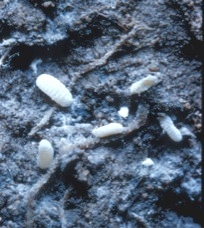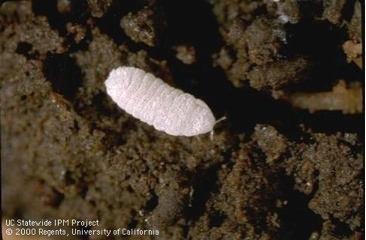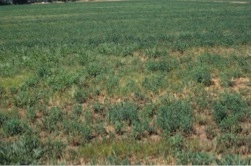Mealybugs are common insect pests of many crops including grapes, citrus, ornamental plants, and various other perennial crops. They feed on trunks, stems, leaves, and roots of plants. At times these infestations can be very obvious on plants due to high mealybug densities, the sticky honeydew that they excrete, and the sooty mold that often grows on the honeydew.
The ground mealybug is an important insect pest of alfalfa, primarily in the Sacramento Valley. This mealybug is a member of a group of species that spend their entire lifecycle below ground. This insect is small (about 1/16" long), whitish, and relatively soft-bodied. Ground mealybugs feed on alfalfa roots by sucking out plant juices, which causes stunting and yellowing of plants. The infestations generally start in small circular areas near the field borders and gradually increase in size up to an acre or so. Within the infested areas, the plant stand is sparse and existing plants yield poorly and weeds often overtake these areas. The best way to find this pest is to dig up alfalfa roots with a shovel, right at the area where there are healthy and stunted alfalfa plants, and look for tiny white dots in the soil that move. The mealybugs produce white webbing and clusters of whitish eggs, so they’re often obvious in the soil. As mealybugs damage plants, they move from weakened to the healthy plants and the area of damage gradually increases. The damage to alfalfa plants will be very apparent in the summer months but less so during the winter and spring.
Some research was conducted on this pest in the mid-1990's by University of California researchers Godfrey, Long, and Pickel. The ground mealybug was found to have three generations per year with peak numbers in early winter, spring, and mid-summer. This pest appears fairly delicate and perhaps susceptible to soil moisture. In fact, the highest ground mealybug populations were generally found at intermediate soil moisture conditions; however, some individuals were found in soils as dry as 7% moisture. Several alfalfa cultivars were studied and there were no trends for mealybug population density by alfalfa variety.
Over the years, several experimental insecticide treatments for ground mealybugs have been studied, but all have had limited to no success. Crop rotation was studied as one means to eliminate this pest from infested soils. Twelve commonly grown crops in the Sacramento Valley were infested with ground mealybugs in a greenhouse study. Some survival occurred on all plant hosts with the density of mealybugs found in the soil of tomatoes and potatoes being significantly higher than that found in sugar beets, field corn, kidney beans, and wheat. However, some level of survival and reproduction was found in all crop plant species. Reproduction on alfalfa was intermediate among the crop species. Ground mealybugs feed on and are a potential pest on several perennial hosts including prunes and almonds. Crop rotation with corn, wheat, or dry beans might be the best rotation option for reducing populations, perhaps coupled with a summer fallow period. In summary, if you see a circular patch in your alfalfa field that is not growing properly, take a look at the roots and soil and look for small white insects that are an indication of a mealybug infestation in your crop.


